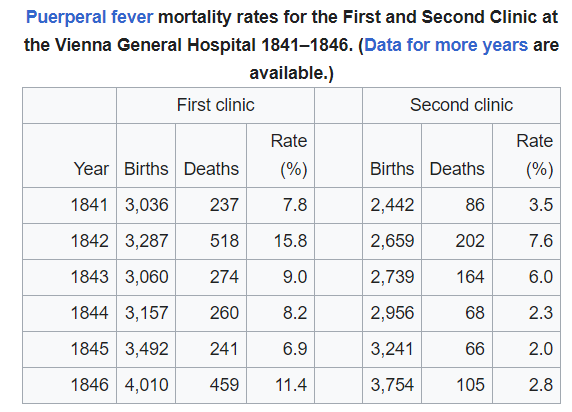COVID Hygiene in The Modern Age
Parallels between 2020s United States and 1800s Vienna, Austria
Do you remember the story of Ignaz Semmelweis? Most do not.
His story is especially important in the modern age of Sars-CoV-2 spread. Three years into a global pandemic, schools are being shut down and hospitals no longer require employees or actively sick patients to mask. All while an extremely contagious virus that disables and kills people continues to spread in the population.
Ignaz was a young Hungarian physician who wondered why more women who gave birth in Vienna General Hospital's first obstetric clinic died from infection than those who, literally, gave birth in the street outside of the hospital.
Today, we have incredible scientific prowess compared to 19th century Vienna. We have PCR, a gamut of therapeutics, vaccines, oxygen on demand, antibiotics, electron microscopy, and complex ECMO machines. We can identify pathogens in mere hours. In 1800s Vienna the concept of invisible ‘germs’ causing illness and death was considered delusional.
Ignaz suggested to his colleagues the novel concept of washing their hands and changing lab coats between dissection lab (of people who died of infection) and assisting with births.
Infectious disease protocols for confirmed Influenza A infections used to include negative air flow rooms, all staff entering the room to wear a mask, and the patient when leaving the room to wear a mask. Sars-CoV-2 is at least 3-4x more infectious than influenza, test positivity rates are routinely higher than even the worst influenza season.
Ignaz even set up an experiment demonstrating that fewer women became infected and died if hygiene protocols were followed. The results were clear.
Graphs and data from Wikipedia.
Mask wearing reduces the spread of infectious disease. A recent Cochrane Review indicated all mask studies combined were not well enough controlled to draw a conclusion; however, several studies have demonstrated mask efficacy (references below). Scientists working with viruses and health care workers have long worn masks in the presence of infected patients. It is part of standard OSHA required PPE for infectious disease work, or at least, it used to be.
Was Ignaz celebrated for this simple and demonstrable medical breakthrough?
No. He was placed in an insane asylum by his colleagues where he died 14 days later, from an infection.
Even in confined spaces or places where actively sick people congregate (hospitals and urgent care centers) few people wear a mask to protect themselves or others. The pendulum has swung from most people wearing masks to even the most routinely exposed shunning them.
Washing one’s hands between patients was seen as a disruption to the work schedule of the doctors, a dirty lab coat was seen as a mark of professionalism at the time. The concept of invisible ‘germs’ was deemed delusional. Ignaz quickly became unpopular and was deemed insane by his colleagues.
The parallels between medical professionals insisting on not wearing masks is striking. Masks to protect their patients, or themselves from infection, and by staying well themselves, protecting future patients have all but disappeared from the clinical setting.
Years after his death the practice of washing one’s hands between patients to reduce the spread of germs was introduced to the practice of western medicine.
As a scientist trained in the modern age of science and medicine, I sincerely hope it does not take us years to figure this out.
Mask Efficacy References:
1. Unmasking the mask studies: why the effectiveness of surgical masks in preventing respiratory infections has been underestimated, Kollepara P.K. et al. J Travel Med. 2021 Sep 6.
2. Mask wearing in community settings reduces SARS-CoV-2 transmission. Leech, G et al. PNAS May 2022
3. Science Brief: Community Use of Masks to Control the Spread of SARS-CoV-2, CDC Dec. 6, 2021
4. Largest study on masks and Covid-19 demonstrates their effectiveness in the real world, Yale University, 2021
Associated research study: "Impact of community masking on COVID-19: A cluster-randomized trial in Bangladesh." Abaluck et al. 2021, Science 375:6577
5. Effectiveness of Face Mask or Respirator Use in Indoor Public Settings for Prevention of SARS-CoV-2 Infection — California, February–December 2021, Andrejko, KL, MMWR February 11, 2022
6. Effectiveness of Mask Wearing to Control Community Spread of SARS-CoV-2, Brooks, JT, JAMA. 2021
7. Lifting Universal Masking in Schools — Covid-19 Incidence among Students and Staff, Cowger, T.L. et al. New England Journal of Medicine, Nov. 2022
8. Coronavirus Face Masks FAQs (Johns Hopkins) Maragakis, L.L. M.D., M.P.H. 2023
More references can be found under the “Mask Studies” header on my Linktree. Note this story is based on a historical account of the life of Ignaz Semmelweis from the book “How to Fly a Horse” by Kevin Ashton, with additional details and references from Wikipedia- Ignaz Semmelweis.






This is a really interesting post! Thanks again for educating us ♥️🙏🏻
Great read! Thanks Lil!